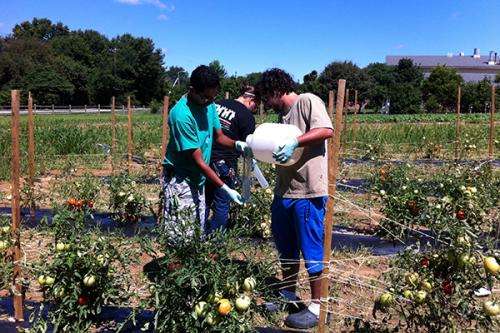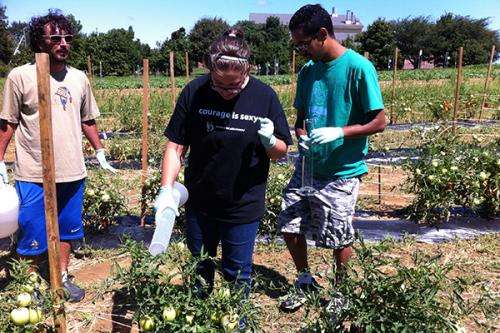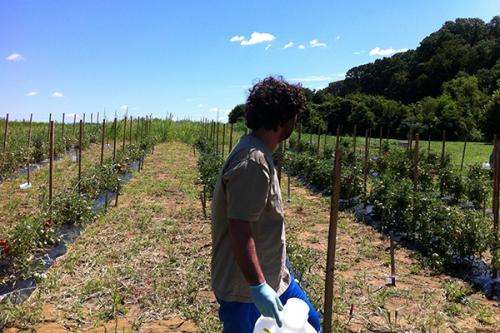UD students look at possible contamination of irrigation water

Students in the University of Delaware College of Agriculture and Natural Resources (CANR) are using a plot of land on the campus farm to help study possible contaminants in soil and irrigation water used to grow leafy greens and tomatoes in order to help inform new regulations on growers that will be going into effect next year as part of the Food Safety Modernization Act.
The study is part of a $9 million U.S. Department of Agriculture (USDA) National Institute of Food and Agriculture (NIFA) Specialty Crops Research Initiative (SCRI) grant titled "Developing Consensus Produce Safety Metrics for Leafy Greens and Tomatoes." The project is led by the University of Maryland and is taking place at seven different universities and industry liaisons across the country.
Signed into law in 2011 by President Barack Obama, the food safety act has been implemented in stages over the past two years.
Kali Kniel, associate professor of animal and food sciences, explained that part of the law includes regulations for growers of fruits and vegetables, noting that this is the first time there have ever been specific regulations for growing fruits and vegetables.
"There have been guidelines and marketing agreements before but not regulations in terms of environmental aspects that are difficult to control," Kniel said, "so growers are anxious and nervous about this."
The rules are not yet finalized and include some fairly complicated aspects in terms of metrics, use of irrigation water and soil amendments. Delaware extension agents have been working with growers over the past two years to make the transition more manageable.
To help inform these regulations, researchers from the seven universities will meet with representatives of the Food and Drug Administration (FDA) to report on their findings.
UD research team
At UD, the research team used a plot of land next to the Allen Laboratory and has been growing tomatoes, romaine lettuce and spinach on the plot for the past two years.

Angela Ferelli, a senior double majoring in biochemistry and food science, worked on the project during the first summer and said that it was interesting to get hands-on experience outside of the lab.
Because it was her first time working in a garden and growing plants for a project, she said that it was a "labor of love. We really wanted to tackle it head on and we didn't know what the best way was to keep the weeds out and keep the plants growing and happy. And if you looked down the rows the first time we planted, we had four rows—they started out straight and then they went crooked, but you could definitely tell that we were doing it, and it was great."
Ferelli said that the next year, the group tested a new variable plasticulture for tomatoes, putting down plastic tarps to keep the weeds out. This is also a means of potential control for splash from rainfall for growing produce and for the protection from plant contact with soil.
Patrick Spanninger, a doctoral student in Kniel's lab who has been working on the project since the beginning, explained that after the students grew the plants, they ran trials by pouring water mixed with manure that contained different levels of E. coli on the plants to monitor bacterial persistence on the fruit. "We wanted to see if the bacteria in the manure that we started with survived after we put it on the plants," said Spanninger. This is a controlled way modeling how irrigation water may become naturally contaminated in real-life situations.
The students then harvested the tomatoes and leafy greens by hand and used random sampling strategies to look at the levels of generic E. coli on the plants.
Explaining that because the outdoors is a complicated, unsterile environment, Kniel said that they tested for generic E. coli because it is an indicator organism, meaning that if increased levels of generic E. coli show up, there could be a potential risk associated with the irrigation water. This is the current industry standard and part of a grower's best practices.
The problem with rain
Another part of the research on which the students worked was the development of water safety metrics to help decide how many generic bacteria—nonpathogenic bacteria—can be found in water used for irrigation.

"They're associating the levels of bacteria in the water with climactic changes with rainfall and wind and relative humidity and temperatures to try and understand what puts produce at risk for having higher bacterial levels or potential pathogens," said Kniel.
Ultimately, Kniel said that rainfall more than anything else poses a problem for growers when it comes to bacterial contamination on fruit that may have originated in irrigation water. Using DNA fingerprint analysis on the recovered E. coli, Spanninger was able to trace bacteria coming from the manure through the tomatoes on different plants.
"We actually are seeing that the initial amounts of generic bacteria in the water are not really the biggest issue. Bacterial decay on plants occurs within a couple of days. Rainfall seems to really affect fresh produce," Kniel said. "We think that rain close to harvest dates is an important consideration and should be part of a Food Safety Plan, so we're sharing with the FDA that aspects other than strict water metrics should be considered. At this time meeting the water standards the FDA is suggesting is difficult for produce growers around the country, in particular those that use surface water for irrigation."
Spanninger agreed with that assessment. "From what we saw, the greatest influence on bacterial presence and persistence was big rain events, which we've been getting more of in recent years." He explained that the research was conducted last fall during Hurricane Sandy and in the summer when the area was doused with a large amount of rainfall.
Spanninger also added that possible contamination from animals—such as geese, dogs, and groundhogs in the field—is another issue that the group is investigating. Wildlife intrusion into produce fields is an important area of study along with irrigation water standards.
In addition to looking for E. coli, the group—along with the research teams at other universities involved in the project—also set out to identify potential hot spots for growers, areas where they would have the most success growing crops without high risk of contamination.
Ferelli explained, "The overarching implications of this research are going to be for the growers to be able to have a better grip on where the risk is in the field. So if a grower goes out now with this risk in mind and he or she see's there has been a rain event, or observes that an animal has come in and left it's signature, instead of just taking out that one plant that has been affected, the grower will be better equipped with knowledge to recognize the possibility to section off several plants in that area.'"
Provided by University of Delaware


















